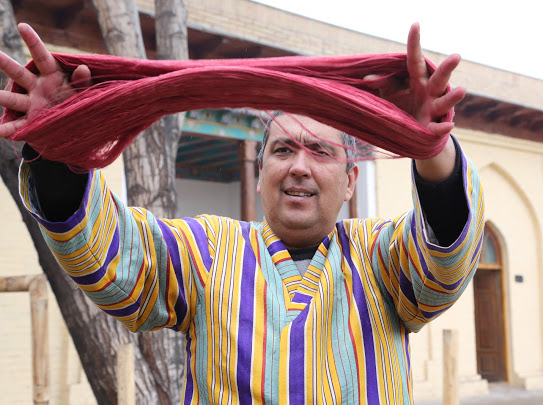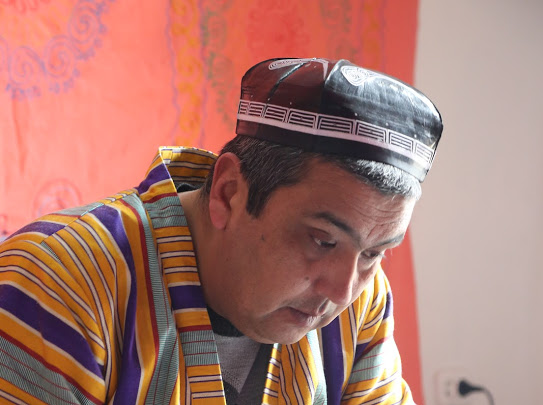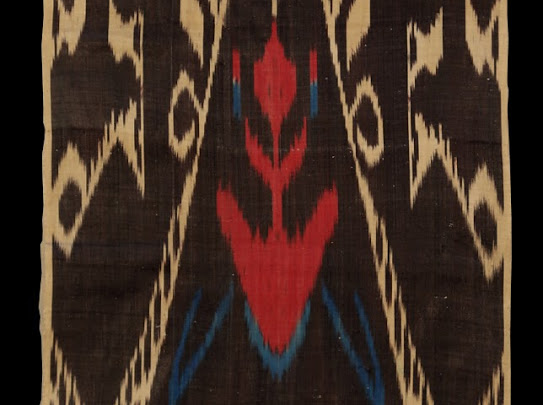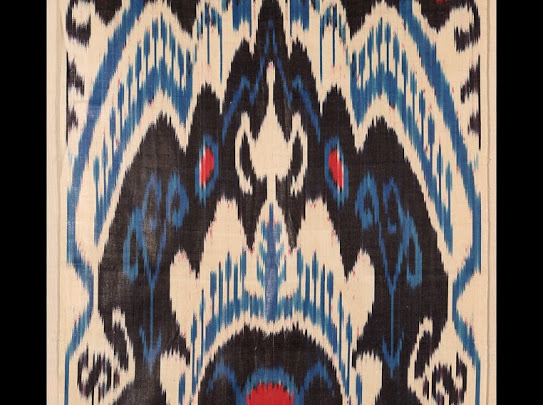Weaving is perhaps one of humanity’s oldest and most basic of crafts. Over the ages, it has evolved from a simple matter of survival – garments to protect us from the elements – to an art form in its own right.
Central Asia has a particularly rich tradition of weaving and in fact, high-quality textiles were so prized here that in Central Asian courts from the 12th century, royal commendation was bestowed not with medals but in the form of ikat robes.
At the crossroads of civilisations, weaving developed fast in Uzbekistan, embracing techniques, tools and designs brought with the Silk Road caravans. Abr fabrics were soon in great demand and, in the lush Ferghana Valley, Margilan was at the heart of the weaving industry.

Secrets and skills were passed from generation to generation. Family dynasties developed distinctive colour schemes, dye recipes and ornamentations. Dexterity and creative flair became an indelible part of their heritage.
Abr reached its height in the 18th and 19th centuries but the globalisation of the 20th century posed a threat to this time-honoured craft as guilds and workshops closed and industrial manufacturing took hold. The traditional ways were in danger of extinction. It was then that one of the true heroes of Uzbek cultural heritage came to the fore: Turgunbai Mirzaakhmedov. A seventh generation abrbandi (or abr-weaver) and head of his family clan, Turgunbai Mirzaakhmedov devoted his whole life to preserving his tradition, and the fabrics he fashioned can proudly take their place among the best examples of Uzbek national weaving.
Atlas silks are still the favourite choice for women’s national dress, and international fashion houses are keen on them, too – Gucci used Uzbek fabrics in their Spring-Summer 2010 collection, while Giorgio Armani looked to Uzbek ikat for his Crossing Colours collection. Collections by Oscar de la Rente also include ala-bakhmal’ velvet as well as adras and atlas (satin ikat) from Margilan.
In his workshop for handwoven fabrics, Turgunbai worked tirelessly to revive the manufacture of fabulous silk fabrics such as shoyi, adras, bekasab, and banoras, a tradition all but lost in the 1950’s and 60’s. Creative as well as a skilled professional, Turgunbai also designed over 100 fabric patterns.
Producing these top quality, handmade fabrics is a labour of love. As many as 38 different steps are involved, with high levels of skill demanded at each stage. But Turgunbai Mirzaakhmedov’s dedication did not go unnoticed. He was the first craftsman from Uzbekistan to be awarded the UNESCO Certificate for Contribution to the Preservation and Development of Traditional Crafts, and he ensured his long-standing dynasty continues.
Now it is Turgunabai’s son, Rasul, who heads the family line. Like his forefathers, Rasul preserves the time-honoured traditions but builds on them, too, bringing imaginative innovation to the age-old craft of Margilan silk manufacture.

Rasul has already proved himself as a master craftsman; at the end of the 1990’s, he began working to revive the tradition of ala-bakhmal, a special velvet ikat reserved for costly, festive garments and previously made only in Bukhara. Yet this prestigious fabric prized throughout Central Asia was only manufactured for a few decades, from 1860-1910. The technique was presumed lost but Rasul has managed to decode its secrets and the sumptuous lengths of velvet are now once more rolling off his looms.

Thanks to the devotion of traditional masters like Turgunbai Mirzaakhmedov, this fascinating, beautiful craft from days gone by is alive and well. And thanks to the Mirzaakhmedov’s creative, innovative approach to dynamic designs and colour combinations, we can be sure these stunning Uzbek fabrics will never be out of fashion.





